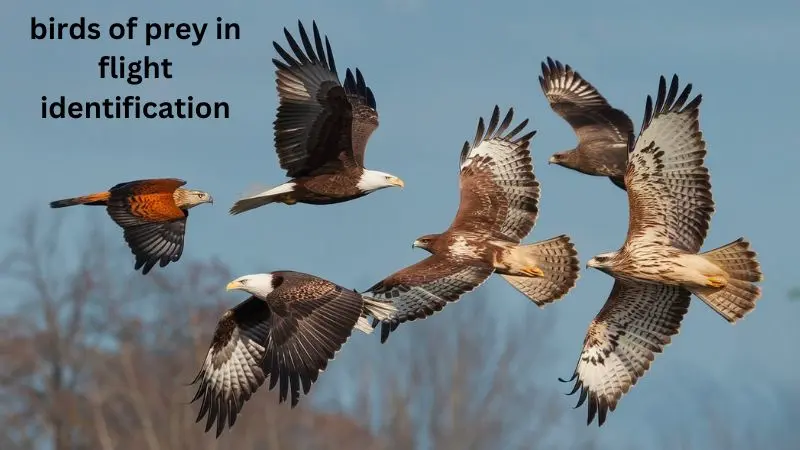Bird Identification
Birds Of Prey In Flight Identification
Birds of prey, or raptors, are some of the most majestic and awe-inspiring creatures in the sky. Their powerful wings, keen eyesight, and remarkable hunting abilities make them fascinating subjects for birdwatchers and nature enthusiasts alike. However, identifying these birds while they are in flight can be a challenging but rewarding endeavor. With over 500 species of birds of prey around the world, ranging from the massive golden eagle to the elusive falcon, knowing the key traits to look for can significantly enhance your birdwatching experience.
This comprehensive guide from Bird01.com is designed to help you identify birds of prey in flight by examining their shape, size, wingbeats, and other distinguishing features. Whether you’re a beginner or a seasoned birder, this article will provide you with the knowledge to better appreciate these magnificent raptors in their natural environment.
Birds Of Prey In Flight Identification
Identifying birds of prey while they soar overhead requires a keen eye and a methodical approach. Unlike when they are perched, flight identification demands you to focus on a range of factors, such as the bird’s silhouette, wing shape, behavior, and the environment it inhabits. Understanding these key identification markers is the first step in mastering the art of birdwatching.
Silhouette and Shape
One of the easiest ways to begin identifying birds of prey in flight is by looking at their silhouette. Raptors typically have strong, bold shapes that are distinctive even at a distance. While every species is different, certain categories of raptors share common characteristics. Hawks, for example, often display broad, rounded wings and fan-shaped tails, making them relatively easy to distinguish from falcons, which have slender, pointed wings and long, narrow tails.
For instance, eagles are large, with broad wings and large heads that project forward in flight, while vultures have a distinctive “V” shape when soaring with their wings held above their bodies. Even from a distance, the overall profile of a bird of prey can give you clues about what species you are looking at. Learning the basic shapes of raptors—whether they are large and bulky like a buteo, slim and agile like an accipiter, or somewhere in between—can help you narrow down the possibilities.
Wing Shape and Flight Style
The shape of a raptor’s wings is another essential factor in identifying birds of prey. Raptors have adapted different wing shapes depending on their hunting strategies and habitats. For example, broad-winged raptors, such as red-tailed hawks, are built for soaring over open fields and forests. Their wide wings enable them to glide for long periods, conserving energy as they scan the ground for prey.
Falcons, on the other hand, have long, pointed wings designed for high-speed flight. This wing shape allows them to dive at incredible speeds when hunting smaller birds. The peregrine falcon, one of the fastest birds in the world, can reach speeds of over 200 mph in a stoop (a high-speed dive). Knowing the flight style and wing shape of different species can be a key indicator of identification, especially for species that share similar habitats.
Tail Shape and Behavior
In addition to wing shape, tail shape can help differentiate between various species of raptors. Tail configurations vary depending on the bird’s hunting style and preferred habitat. For example, hawks in the genus Buteo, such as the red-shouldered hawk, typically have broad, fan-shaped tails that they use for quick maneuvering in dense forests. Falcons, by contrast, possess long, narrow tails that provide aerodynamic advantages during fast, agile pursuits.
Behavior in flight is equally important in identification. Vultures are often seen circling high in the sky, taking advantage of thermal updrafts to stay aloft with minimal effort. In contrast, a falcon may be observed in fast, direct flight or diving at incredible speeds toward its prey. Paying attention to how a bird of prey moves in the air—whether it’s soaring, flapping, or gliding—can help you understand what species you’re watching.

Plumage and Markings
Although plumage can sometimes be difficult to observe while a bird is in flight, especially at a distance, it can still provide valuable information. Many birds of prey have distinctive color patterns or markings that help set them apart from others. For instance, the American kestrel has a unique combination of rusty red, blue-gray, and black markings, which make it easily identifiable even when flying. Similarly, the bald eagle’s white head and tail are telltale signs, even at great distances.
Juvenile raptors can be trickier to identify because their plumage often differs from that of adults. For example, young bald eagles lack the iconic white head and tail, making them look more like golden eagles until they mature. Additionally, lighting and distance can make it challenging to see specific markings, so combining plumage observations with other factors, such as size, shape, and flight behavior, is essential for accurate identification.
Size and Proportion
Relative size and proportion are helpful factors in distinguishing between different species of birds of prey. Size alone can be misleading, as a large bird seen at a great distance can appear small, and vice versa. However, comparing a raptor’s size to other birds nearby can give you a sense of scale. For example, a bald eagle is much larger than a red-tailed hawk, but if you see them alone, the difference may not be immediately apparent.
Proportionally, larger birds of prey, such as eagles, have broader wings and longer tails than smaller birds like hawks and falcons. These physical proportions, combined with the bird’s flight characteristics, provide critical clues in the identification process. Learning to judge size and proportion in relation to nearby objects or other birds is an invaluable skill in birdwatching.
Seasonal and Geographic Factors
Birds of prey are highly migratory, with many species traveling vast distances to find food or to breed. Understanding the migratory patterns of raptors can greatly aid in identification. For example, certain species of hawks and falcons may only appear in a specific region during migration seasons, making it easier to narrow down your identification options based on the time of year and location.
For example, the broad-winged hawk, a common migratory raptor in North America, travels from the United States and Canada to South America during the fall. Knowing when and where these migrations occur can increase your chances of spotting certain species in flight. In contrast, birds like the red-tailed hawk are year-round residents in many parts of North America, making them a common sight throughout the year.
Habitat and Behavior
Understanding the habitat preferences of birds of prey is another useful tool for identification. Different species have evolved to thrive in specific environments, which can help you anticipate what type of raptor you might encounter in a given location. For instance, ospreys are almost always found near bodies of water, as their diet consists primarily of fish. If you see a large bird of prey with long wings and a distinctive white underbelly circling a lake or river, it’s likely an osprey.
Similarly, birds like the northern harrier can often be seen flying low over marshes and grasslands, using their long wings and tail to glide close to the ground as they hunt for small mammals. Learning the preferred habitats of different raptor species can significantly narrow down your identification choices.
Common Birds of Prey in Flight
To further aid in identification, let’s explore some of the most common birds of prey you are likely to encounter while birdwatching.
Red-tailed Hawk
The red-tailed hawk is one of the most common and widespread raptors in North America. Its broad, rounded wings and short, wide tail make it easy to spot in flight. Adult red-tailed hawks often display a distinctive reddish-brown tail, though juveniles may lack this coloration. These birds are frequently seen soaring over open fields, scanning the ground for rodents and other small prey.
Bald Eagle
Known for its striking white head and tail, the bald eagle is one of the most iconic birds of prey in North America. In flight, bald eagles have large, broad wings and a heavy, slow wingbeat. They are often seen near bodies of water, as fish make up a significant part of their diet. Juvenile bald eagles are dark brown and can be mistaken for golden eagles until they reach maturity.
Peregrine Falcon
The peregrine falcon is renowned for its speed and agility, particularly during its hunting stoop. With long, pointed wings and a streamlined body, this falcon can reach incredible speeds when diving toward its prey. Peregrine falcons are found in a variety of habitats, including urban areas where they often nest on tall buildings.
Golden Eagle
Golden eagles are large raptors with long, broad wings and a powerful flight. They are often seen soaring in open areas such as mountains and deserts, using their keen eyesight to spot prey from great heights. Their wings are slightly upturned in flight, giving them a distinctive silhouette.
Osprey
Ospreys are unique among raptors because of their specialized diet of fish. They are commonly seen near lakes, rivers, and coastal areas, where they hover above the water before diving to catch fish. In flight, ospreys have long, narrow wings with a distinct crook and dark patches at the “wrists.”
Conclusion
Identifying birds of prey in flight is a skill that requires patience, practice, and attention to detail. By focusing on key features such as silhouette, wing shape, tail configuration, and behavior, you can develop a deeper appreciation for these magnificent birds and the environments they inhabit. Armed with the knowledge from this guide by Bird01.com, you’ll be well on your way to becoming an expert in raptor identification. Remember, the more time you spend observing these incredible creatures, the better you’ll become at recognizing their subtle differences. Happy birdwatching!






